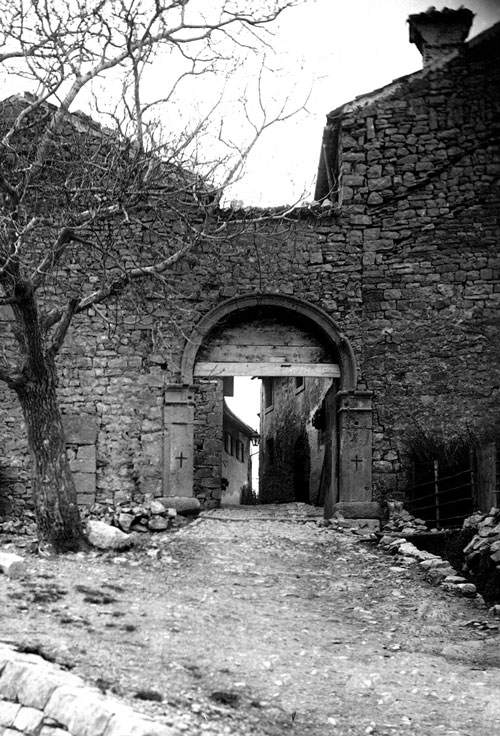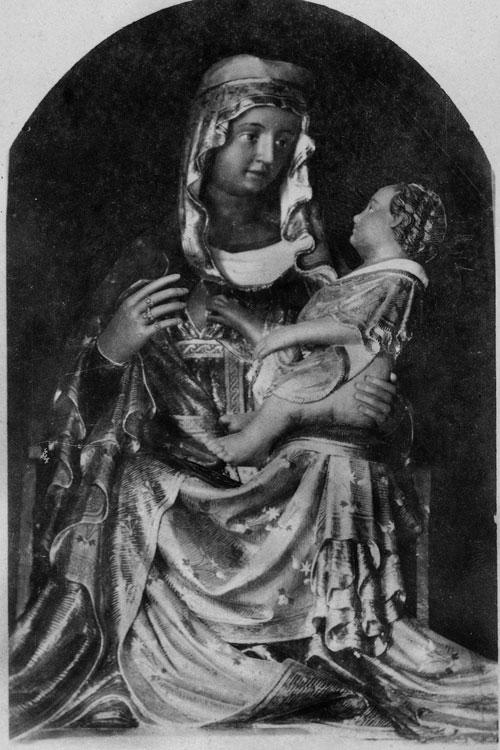 The Marian sanctuary of Castelmonte stands on the top of a mountain 618 meters above sea level, in the chain of the Julian Pre-Alps, 9 kilometers from Cividale del Friuli, and about 25 kilometers from Udine.
The Marian sanctuary of Castelmonte stands on the top of a mountain 618 meters above sea level, in the chain of the Julian Pre-Alps, 9 kilometers from Cividale del Friuli, and about 25 kilometers from Udine.
The place was originally a Roman military post. The foundation of the sanctuary is probably very remote: some clues refer to a sacellum, perhaps from the V-VII centuries.
Taking into account that, since its birth, Castelmonte found itself in the sphere of influence of the Patriarchate of Aquileia, characterized by singular Marian fervor, the hypothesis is likely that Christian Roman soldiers of the garrison of Cividale (at the time "Forum Julii "), or peasants who had taken refuge on the top of the mountain on the occasion of some raid carried out, or simply feared, by barbarians who came from the east, have brought up there signs of their faith and their devotion in a context in which the cult Mariano intertwined with that of the Archangel Michael (the crypt of the sanctuary is dedicated, in fact, to the warrior Archangel). The first Apostolic Church was particularly devoted to St. Michael and the Lombards, who arrived in Cividale in 568, elected the Archangel Michael as their patron. These remote origins make Castelmonte one of the oldest Marian sanctuaries in northeastern Italy.
It can be thought that already from the time of the Lombards and the Franks, i.e. from the 6th to the 9th century, numerous Christian pilgrims went to Castelmonte since a document from 1244 presents Castelmonte which had already reached a notable splendour: the church of "Santa Maria del Monte" was at that time one of the most important of the entire extended Patriarchate of Aquileia.
Unfortunately the written documentation is rather late compared to the period in which it is thought that a Marian devotion began in Castelmonte; the first document that casually mentions "Santa Maria del Monte", due to a matter of borders, is dated 18 May 1175. The second document, in order of antiquity, that has come down to us, is the one just mentioned above: it bears the date 20 December 1244; at that time the sanctuary was considered a safe garrison, a fortress surrounded by clear signs of Mary's protection.
For this reason it can be assumed that the legend with which this short guide begins has somehow sublimated the collective memory of the terrible barbarian invasions. The prayers of intercession to the Virgin and the strenuous defense of the mountain made Castelmonte considered a place sacred to Mary and an inviolable fortress in defense of the underlying plain.
In 1253 the sanctuary, already fortified and guarded with weapons to protect pilgrims and enlarged to become a village, passed into the ownership of the Chapter of Santa Maria Assunta in Cividale: the construction of a portico in front of the church for the shelter for pilgrims.
Other works in the church became necessary in the mid-14th and in the first decades of the 15th century to adapt the sanctuary to the needs of an ever-increasing flow of faithful and to strengthen the defensive structures against the Turks. The place, however, was never subjected to sieges. The only gate of the village was closed in the evening but only to prevent the entry of thieves and gangs of criminals who roamed in large numbers in those lonely borderlands. The door facing east is called Pocacilla's, from the Slovenian Poklecila, which means "kneeler", in fact, a stone of this shape, where pilgrims stopped in prayer, was nearby. Slavic populations had settled in the area since the eighth century.
 On September 21, 1469, lightning of unprecedented power struck the top of the mountain, causing the bell tower and a large part of the church to collapse; a furious fire then developed which reduced the ancient effigy of the Virgin venerated here to ashes and reduced the entire sanctuary to ruins. At the behest of the neighboring populations and by decision of the Canons of Cividale, the reconstruction of the entire complex began immediately. The reconstruction could be considered completed in 1479, the year in which the peace between the Ottoman Empire and Venice was also concluded. These two anniversaries meant that on 8 September 1479 there was a "great pardon" in Castelmonte, with the participation of many pilgrims.
On September 21, 1469, lightning of unprecedented power struck the top of the mountain, causing the bell tower and a large part of the church to collapse; a furious fire then developed which reduced the ancient effigy of the Virgin venerated here to ashes and reduced the entire sanctuary to ruins. At the behest of the neighboring populations and by decision of the Canons of Cividale, the reconstruction of the entire complex began immediately. The reconstruction could be considered completed in 1479, the year in which the peace between the Ottoman Empire and Venice was also concluded. These two anniversaries meant that on 8 September 1479 there was a "great pardon" in Castelmonte, with the participation of many pilgrims.
Historians believe that, precisely on the occasion of this "great pardon", the stone statue of the "living Madonna", still venerated in Castelmonte, was enthroned and blessed. The statue, carved in stone, dates back to the first decades of the fifteenth century and is the work of a probably local craftsman in the manner of the Salzburg School.
Other events are recorded in the centuries-old history of the sanctuary: such as the earthquakes of 1511 and 1513 which led to extensive reconstruction of the nave of the church and its floor.
Towards the middle of the sixteenth century, Giovanni da Udine, fulfilling a vow, executed the stuccos for the chapel of the Madonna, removed at the end of that century and, according to some scholars, the decoration of the crypt of San Michele, canceled by repainting and by the transformation, between 1954 and 1964, of the crypt itself in the "lower church".
The patriarch Francesco Barbaro (1593-1616) attributed the preservation of Friuli from Protestantism, which had instead spread to other regions, to the Virgin of Castelmonte. In 1647 master Iseppo Cantinella from Cividale began the reconstruction of the castle walls. From 1724 to 1728, the dormitories for pilgrims were enlarged and reformed. In 1732, based on a design by Francesco Andrioli, the master G. Batta Vincenzutto began the extension works of the church and the new choir.
A historic date for Castelmonte is that of May 15, 1744; on that day the patriarch of Aquileia Daniele Delfino proceeded with the consecration of the church, deeply renovated in the nave. In this circumstance, the concourse of pilgrims was particularly numerous. An important event of the eighteenth century - of which the memory later almost vanished - was the aggregation of the sanctuary to the basilica of Santa Maria Maggiore in Rome, decreed by that Chapter, on 15 December 1748. By virtue of this aggregation the sanctuary was admitted to participate in all the graces, indulgences, indults and privileges proper to the Roman basilica.
In 1913 the then archbishop of Udine, mgr. Anastasio Rossi, entrusted the care of the sanctuary to the Capuchin Friars. The first Capuchin custodian was Fr. Eleuterio da Rovigo who arrived there at the age of 38, on 6 September 1913, and died there in 1935. Thanks to his interest, the village of Castelmonte was reached by the electricity grid (in 1927), obtained the elementary school and the post office . During the First World War the sanctuary was very close to the bloody battlefields. The border ran along the Judrio river, which the Italian army crossed by settling on the Isonzo. After the rout of Caporetto, the chronicles record a deplorable episode of desecration of the sanctuary. Those were desperate times.
At the end of the conflict, religious life also resumed with the reconstruction. The pilgrimage of 3 September 1922, when the statue was crowned, was memorable.
During the Second World War, Castelmonte was twice targeted by German cannons, on 6 and 18 November 1943, due to partisan units believed to be nestled there. The second time the bombardment did not last long as the breech of a gun exploded almost immediately killing a German. The population and the Capuchins had taken refuge in the crypt where the statue had also been taken and remained there for a year and a half. On 5 July 1945, after a solemn pontifical, it was brought back to its niche which in the meantime had been enlarged and embellished with the addition of a mosaic.
Between the end of the 1940s and the 1980s, the complex took on its present configuration: in 1930 the facade of the church underwent a profound makeover, while the bell tower, from 1475, already modified in the 17th century, had three other elevations , the last of which in 1954. The inauguration of the aqueduct, the arrangement of the steps, the erection of the luminous cross on the Campuc hill, the excavation of the large parking lot on the ridge of the mountain and the installation of the elevator for pilgrims.
The earthquake of May and September 1976 shook Friuli causing a thousand deaths. The friars of Castelmonte proposed a pilgrimage to the sanctuary, to propitiate the material and moral reconstruction of those lands. Since then on September 8 every year he sees thousands of devotees, led by the archbishop of Udine, walk up there to thank the Mother of God and implore her protection.